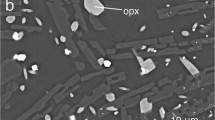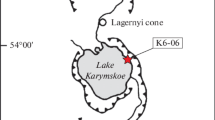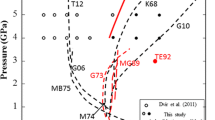Abstract
Dacitic magma, a mixture of high-temperature (T) aphyric magma and low-T crystal-rich magma, was erupted during the 1991–1995 Mount Unzen eruptive cycle. Here, the crystallization processes of the low-T magma were examined on the basis of melt inclusion analysis and phase relationships. Variation in water content of the melt inclusions (5.1–7.2 wt% H2O) reflected the degassing history of the low-T magma ascending from deeper levels (∼250 MPa) to a shallow magma chamber (∼140 MPa). The ascent rate of the low-T magma decreased markedly towards the emplacement level as crystal content increased. Cooling of magma as well as degassing-induced undercooling drove crystallization. With the decreasing ascent rate, degassing-induced undercooling decreased in importance, and cooling became more instrumental in crystallization, causing local and rapid crystallization along the margin of the magma body. Some crystals contain scores of melt inclusions, whereas there are some crystals without any inclusions. This heterogeneous distribution suggests the variation in the crystallization rate within the magma body; it also suggests that cooling was dominant cause for melt entrapment. Numerical calculations of the cooling magma body suggest that cooling caused rapid crystal growth and enhanced melt entrapment once the magma became a crystal-rich mush with evolved interstitial melt. The rhyolitic composition of melt inclusions is consistent with this model.






Similar content being viewed by others
References
Anderson AT Jr, Brown GG (1993) CO2 contents and formation pressures of some Kilauean melt inclusions. Am Mineral 78:794–803
Anderson AT Jr, Newman S, Williams SN, Druitt TH, Skirius C, Stolper E (1989) H2O, CO2, Cl, and gas in Plinian and ash-flow Bishop rhyolite. Geology 17:221–225
Barclay J, Carroll MR, Houghton BF, Wilson CJN (1996) Pre-eruptive volatile content and degassing history of an evolving peralkaline volcano. J Volcanol Geotherm Res 74:75–87
Blundy J, Cashman K (2001) Ascent-driven crystallisation of dacite magmas at Mount St Helens, 1980–1986. Contrib Mineral Petrol 140:631–650
Cashman KV (1992) Groundmass crystallization of Mount St Helens dacite, 1980–1986: a tool for interpreting shallow magmatic processes. Contrib Mineral Petrol 109:431–449
Cashman KV, Blundy J (2000) Degassing and crystallization of ascending andesite and dacite. Philos Trans R Soc Lond A 358:1487–1513
Couch S, Sparks RSJ, Carroll MR (2003) The kinetics of degassing-induced crystallization at Soufrière Hills Volcano, Montserrat. J Petrol 44:1477–1502
Devine JD, Gardner JE, Brack HP, Layne GD, Rutherford MJ (1995) Comparison of microanalytical methods for estimating H2O contents of silicic volcanic glasses. Am Mineral 80:319–328
Druitt TH, Bacon CR (1989) Petrology of the zoned calcalkaline magma chamber of Mount Mazama, Crater Lake, Oregon. Contrib Mineral Petrol 101:245–259
Feeley TC, Dungan MA (1996) Compositional and dynamic controls on mafic–silicic magma interactions at continental arc volcanoes: Evidence from Cordón El Guadal Tatara–San Pedro complex, Chile. J Petrol 37:1547–1577
Geschwind C-H, Rutherford MJ (1995) Crystallization of microlites during magma ascent: the fluid mechanics of 1980–1986 eruptions at Mount St Helens. Bull Volcanol 57:356–370
Hammer JE, Cashman KV, Hoblitt R, Newman S (1999) Degassing and microlite crystallization during the pre-climactic events of the 1991 eruption of the Mt. Pinatubo, Philippines. Bull Volcanol 60:355–380
Hildreth W (1981) Gradients in silicic magma chambers: implications for lithospheric magmatism. J Geophys Res 86:10153–10192
Holtz F, Johannes W, Tamic N, Behrens H (2001) Maximum and minimum water contents of granitic melts generated in the crust: a reevaluation and implications. Lithos 56:1–14
Holtz F, Sato H, Lewis J, Behrens H, Botcharnikov R (2002) Phase equilibrium study and constraints on pre-eruptive conditions of Unzen magmas. In: International workshop on Unzen Scientific Drilling Project Extended Abstract, pp 9–10
Huppert HE (1986) The intrusion of fluid mechanics into geology. J Fluid Mech 173:557–594
Huppert HE, Sparks RSJ (1988a) The generation of granitic magmas by intrusion of basalt into continental crust. J Petrol 29:599–642
Huppert HE, Sparks RSJ (1988b) Melting the roof of a chamber containing a hot, turbulently convecting fluid. J Fluid Mech 188:107–131
Ihinger PD, Hervig RL, McMillan PF (1994) Analytical methods for volatiles in glasses. In: Carroll MR, Holloway JR (eds) Volatiles in magmas. Mineral Soc Am Rev Mineral 30:67–122
Johnson MC, Anderson AT Jr, Rutherford MJ (1994) Pre-eruptive volatile contents of magmas. In: Carroll MR, Holloway JR (eds) Volatiles in magmas. Mineral Soc Am Rev Mineral 30:281–330
Johnson MC, Rutherford MJ (1989) Experimental calibration of the aluminum-in-hornblende geobarometer with application to the Long Valley caldera (California) volcanic rocks. Geology 17:837–841
Kawamoto T (1992) Dusty and honeycomb plagioclase: indicators of processes in the Uchino stratified magma chamber, Izu Peninsula, Japan. J Volcanol Geotherm Res 49:191–208
Kawamoto T. Kagi H, Yamashita S, Matsukage K, Handa T, Ikemoto Y, Moriwaki T, Kimura H (2003) Mid infrared throughput with 5 μm aperture for H2O determination of an andesitic glass: comparison of synchrotron radiation source at Spring-8 with conventional light sources. Geochem J 37:253–259
Koyaguchi T, Kaneko K (1999) A two-stage thermal evolution model of magmas in continental crust. J Petrol 40:241–254
Koyaguchi T, Kaneko K (2000) Thermal evolution of silicic magma chambers after basalt replenishments. Trans R Soc Edinb Earth Sci 91:47–60
Kuritani T (1999) Phenocryst crystallization during ascent of alkali basalt magma at Rishiri Volcano, northern Japan. J Volcanol Geotherm Res 88:77–97
Kusakabe M, Sato H, Nakada S, Kitamura T (1999) Water contents and hydrogen isotopic ratios of rocks and minerals from the 1991 eruption of Unzen volcano, Japan. J Volcanol Geotherm Res 89:231–242
Lejeune A-M, Richet P (1995) Rheology of crystal-bearing silicate melts: an experimental study at high viscosities. J Geophys Res 100:4215–4229
Lofgren G (1980) Experimental studies on the dynamic crystallization of silicate melts. In: Hargraves RB (ed) Physics of magmatic processes. Princeton University Press, Princeton, NJ, pp 487–551
Lowenstern JB (1994) Chlorine, fluid immiscibility, and degassing in peralkaline magmas from Pantelleria, Italy. Am Mineral 79:353–369
Lowenstern JB (1995) Applications of silicate-melt inclusions to the study of magmatic volatiles. In: Thompson JFH (ed) Fluids and ore deposition. Mineral Assoc Can Short Course Ser 23:71–99
Marsh BD (1981) On the crystallinity, probability of occurrences and rheology of lava and magma. Contrib Mineral Petrol 78:85–98
Melson WG (1983) Monitoring the 1980–1982 eruptions of Mount St. Helens: compositions and abundance of glass. Science 221:1387–1391
Nakada S, Fujii T (1993) Preliminary report on the activity at Unzen Volcano (Japan), November 1990–November 1991: dacite lava domes and pyroclastic flows. J Volcanol Geotherm Res 54:319–333
Nakada S, Motomura Y (1997) Magma chamber of Unzen volcano and origin of phenocrysts and enclaves (in Japanese). Bull Volcanol Soc Jpn 40:167–174
Nakada S, Motomura Y (1999) Petrology of the 1991–1995 eruption at Unzen: effusion pulsation and groundmass crystallization. J Volcanol Geotherm Res 89:173–196
Nakada S, Shimizu H, Ohta K (1999) Overview of the 1990–1995 eruption at Unzen Volcano. J Volcanol Geotherm Res 89:1–22
Nakamura M (1995) Continuous mixing of crystal mush and replenished magma in the ongoing Unzen eruption. Geology 23:807–810
Nakamura M (1996) Time scale of magma mixing in Unzen eruption from 1991 to 1993: continuous mixing model of crystal-rich magma and replenished magma (in Japanese with English abstract). Mem Geol Soc Jpn 46:127–138
Nielsen CH, Sigurdsson H (1981) Quantitative method for electron microprobe analysis of sodium in natural and synthetic glasses. Am Mineral 66:547–552
Ogo Y, Yamashita S (1999) Preparation of thin glass wafer for infrared spectroscopy (in Japanese). Bull Volcanol Soc Jpn 44:251–255
Ohlhorst S, Behrens H, Holtz F (2001) Compositional dependence of molar absorptivities of near-infrared OH- and H2O bands in rhyolitic to basaltic glasses. Chem Geol 174:5–20
Peck DL (1978) Cooling and vesiculation of Alae lava lake, Hawaii. US Geol Surv Prof Pap 935-B
Piwinskii AJ, Wyllie PJ (1968) Experimental studies of igneous rock series: a zoned pluton in the Wallowa batholith, Oregon. J Geol 76:205–234
Roedder E (1984) Fluid inclusions. Mineral Soc Am Rev Mineral 12:1–646
Rutherford MJ, Sigurdsson H, Carey S (1985) The May 18 1980 eruption of Mount St. Helens, 1. Melt compositions and experimental phase equilibria. J Geophys Res 90:2929–2947
Rutherford MJ, Hill PM (1993) Magma ascent rates from amphibole breakdown: an experimental study applied to the 1980–1986 Mount St. Helens eruptions. J Geophys Res 98:19667–19685
Rutherford MJ, Devine JD (2003) Magmatic conditions and magma ascent as indicated by hornblende phase equilibria and reactions in the 1995–2002 Soufrière Hills magma. J Petrol 44:1433–1454
Ryan MP (1987) Neutral buoyancy and the mechanical evolution of magmatic systems. In: Mysen BO (ed) Magmatic processes: physicochemical principles. Geochem Soc Spec Publ 1:259–287
Sahagian DL, Proussevitch AA (1996) Thermal effects of magma degassing. J Volcanol Geotherm Res 74:19–38
Saito G, Kazahaya K, Shinohara H, Stimac J, Kawanabe Y (2001) Variation of volatile concentration in a magma system of Satsuma–Iwojima volcano deduced from melt inclusion analyses. J Volcanol Geotherm Res 108:11–31
Sato H (1996) A model of the 1991 eruption of Unzen volcano inferred from petrographic textures of the ejecta (in Japanese with English abstract). Mem Geol Soc Jpn 46:115–125
Sato H, Nakada S, Fujii T, Nakamura M, Suzuki-Kamata K (1999) Groundmass pargasite in the 1991–1995 dacite of Unzen volcano: phase stability experiments and volcanological implications. J Volcanol Geotherm Res 89:197–212
Shaw HR (1980) The fracture mechanisms of magma transport from the mantle to the surface. In: Hargraves RB (ed) Physics of magmatic processes. Princeton University Press, Princeton, NJ, pp 201–264
Sparks RSJ, Huppert HE, Turner JS (1984) The fluid dynamics of evolving magma chambers. Philos Trans R Soc Lond A 310:511–534
Sparks RSJ, Murphy MD, Lejeune A-M, Watts R, Barclay J, Young SR (2000) Control on emplacement of the andesite lava dome of the Soufrière Hills volcano by degassing-induced crystallization. Terra Nova 12:14–20
Swanson SE (1977) Relation of nucleation and crystal-growth rate to the development of granitic texture. Am Mineral 62:966–978
Swanson SE, Fenn PM (1986) Quartz crystallization in igneous rocks. Am Mineral 71:331–342
Turcotte DL, Schubert G (1982) Geodynamics. Wiley, New York
Turner JS (1973) Buoyancy effects in fluids. Cambridge University Press, Cambridge, pp 1–368
Venezky DY, Rutherford MJ (1999) Petrology and Fe–Ti oxide reequilibration of the 1991 Mount Unzen mixed magma. J Volcanol Geotherm Res 89:213–230
Vogel TA, Aines R (1996) Melt inclusions from chemically zoned ash flow sheets from the Southwest Nevada Volcanic Field. J Geophys Res 101:5591–5610
Walker GPL (1989) Gravitational (density) controls on volcanism, magma chambers and intrusions. Aus J Earth Sci 36:149–165
Withers AC, Behrens H (1999) Temperature induced changes in the NIR spectra of hydrous albitic and rhyolitic glasses between 300 and 100 K. Phys Chem Minerals 27:119–132
Wolf KJ, Eichelberger JC (1997) Syneruptive mixing, degassing and crystallization at Redoubt Volcano, eruption of December 1989 to May 1990. J Volcanol Geotherm Res 75:19–37
Wright TL, Peck DL, Shaw HR (1976) Kilauea lava lakes: natural laboratories of study of cooling, crystallization and differentiation of basaltic magma. In: Sutton GH, Manghnani NH, Moberly R (eds) The geophysics of the Pacific Ocean basin and its margin. Am Geophys Union, Washington, DC, pp 375–390
Yamashita S (1999) Experimental study of the effect of temperature on water solubility in natural rhyolite melt to 100 MPa. J Petrol 40:1497–1507
Yamashita S, Kitamura T, Kusakabe M (1997) Infrared spectroscopy of hydrous glasses of arc magma compositions. Geochem J 31:169–174
Yokose H, Yamamoto S (1996) Crustal xenolith from the Kinbo volcanic rocks: Part I. Deep-crustal components of northwest Kyushu (In Japanese with English abstract). J Mineral Petrol Econ Geol 91:86–101
Acknowledgements
We thank S. Sparks for his constructive comments on an earlier version of the manuscript. Careful and thoughtful reviews by M. Rutherford, H. Sato and H. Shinohara improved the manuscript. K.N. thanks S. Nakada, C-H. Chen, Y. Yamaguchi, G. Saito, M. Nakamura, M. Yamamoto, T. Yanagi, T. Nishiyama, K. Takemura, S. Ohsawa, T. Shibata, M. Yoshikawa and J. Yamamoto for valuable discussions and encouragement during this work. This work was financially supported by the Nissan Science Foundation, Kyoto University, and 21st century COE program
Author information
Authors and Affiliations
Corresponding author
Additional information
Editorial responsibility: H Shinohara
Appendices
Appendix A:
Thermal evolution model in the magma body
The calculation method used for the modeling of a cooling magma body is described here. Piwinskii and Wyllie (1968) heated a granodiorite (sample 766 with 69.4% SiO2, similar to Unzen low-T magma) under water-saturated conditions at 200 MPa, and reported the relationship between melt fraction and temperature. About 50 vol% melting or crystallization occurs within a small temperature interval near to solidus (Fig. A1a). In order to approximate this behavior, we used linear relationships between the temperature T and crystal fraction ?as
a Relationship between melt fraction and temperature (solid line) for water-saturated granodiorite composition at 200 MPa (modified after Piwinskii and Wyllie 1968). Starting material is Sample 766 with 69.4 wt% SiO2 in Piwinskii and Wyllie (1968). The stable phase assemblage changes at the intersections of solid line and dotted lines. b Assumption of a linear relationship between temperature and crystal fraction used in the thermal evolution modeling. T S and T L denote the solidus and liquidus temperatures, respectively
and
where T L and T S are the liquidus and solidus temperatures, respectively. The values used for calculation are shown in Table 3. We assume a dacitic composition for both the magma and the country rock, because a petrological study has suggested that the upper crust has dacitic (granodioritic) compositions in this area (Yokose and Yamamoto 1996). Even though the country rock is not saturated with water, the melting occurs under water-saturated conditions as far as melt, magma-derived vapor and solid can coexist at the solid-magma interface. We, therefore, consider a single relationship between crystal fraction and temperature (Fig. A1b) for both melting and crystallization event (Huppert and Sparks 1988a). The crystals in the magma body are assumed to be small enough to remain suspended in the vigorously convecting magma (Sparks et al. 1984) for simplification.
We consider a layer of hot dacitic magma to have initial temperature T 0 and vertical thickness of 500 m, and that the solid roof has initial temperature T ∞ and is of large thickness. The mode of heat and mass transfer changes greatly at a critical melt fraction bounding fluidal magma and immobile magma with a large crystal content (partially molten solid, hereafter). Above the critical melt fraction (C&M stage), heat and mass are efficiently transferred by vigorous convection; below it (CC stage), such transfer occurs only by conduction and diffusion (Huppert and Sparks 1988a). Experimental and theoretical studies indicate that a drastic transition in mechanical properties of a crystal-melt mixture occurs within a narrow range of the melt fraction, between 30 and 50% (e.g. Shaw 1980; Marsh 1981). The temperature at the critical melt fraction is called the ‘effective fusion temperature (EFT)’ (Huppert and Sparks 1988a, 1988b; Koyaguchi and Kaneko 1999, 2000). For our calculations, the critical melt fraction and the EFT were assumed to be 50% and 730°C, respectively.
Because the temperature at the boundary between the partially molten solid and the fluidal magma is fixed at the EFT and the magma temperature is higher than the EFT in the C&M stage, the magma can convect vigorously due to the temperature gradient in the magma (Koyaguchi and Kaneko 2000). The heat flux from the fluidal magma into the partially molten solid can be estimated from the Rayleigh-Nusselt relationship Nu ∝ Ra1/3 (Turner 1973; Turcotte and Schubert 1982) as
, where k, α, g, κ, ν, T m and T EFT are the thermal conductivity, thermal expansion, gravitational acceleration, thermal diffusivity, kinematic viscosity, magma temperature and the effective fusion temperature, respectively, and b is a constant. In the C&M stage, the migration rate of the solid-magma boundary, da/dt, is given by the conservation of heat at the boundary as
, where F s is the heat flux from the interface to the solid, ρ is the density, L is the latent heat, and Δ is the difference in crystal fraction between the interface and the magma body. In a quasi-steady state, the rate of boundary migration can be obtained analytically (Huppert 1986; Koyaguchi and Kaneko 2000) as
This study adopts Eq. (A.5) for the calculation of boundary migration. Conservation of heat in the magma body requires that
where H is the height of the magma body and c is the specific heat. After convection ceases, the magma cools by heat conduction. This process can be expressed as
where d/dT is obtained from Eqs. (A.1) and (A.2). The heat conduction in partially molten crust (T>T s) is also calculated using Eq. (A.7). Following Koyaguchi and Kaneko (2000), we assumed that the C&M stage and CC stage were bounded by T EFT + 10°C, evaluating the time scale of the C&M stage by the time taken for T m to reach T EFT + 10°C, as the timescale for T m to reach T EFT exactly is infinite.
Appendix B:
Possible temperature increase due to decompression crystallization
During the magma ascent from deeper level (250 MPa) to the emplacement level (140 MPa), if no heat was lost to the surroundings, the crystallization caused by decompression inevitably increases the temperature of magma. When the density difference between crystal and melt is sufficiently small, the energy balance requires that
The relationship between crystal fraction and temperature at 140 MPa can be expressed in the same way as Eq. (A.2). In Fig. 4, the quartz stability curve is sub-parallel with the solidus curve and about 50°C higher than the solidus. The crystal fraction between the solidus and the quartz stability curve at 140 MPa can be written as
provided that crystal fraction on the quartz stability limit (780°C) is 50%. If the magma with 730°C and 50% crystals at 250 MPa is decompressed to 140 MPa, the magma temperature and its crystal fraction becomes 764°C and 65%, respectively.
Rights and permissions
About this article
Cite this article
Nishimura, K., Kawamoto, T., Kobayashi, T. et al. Melt inclusion analysis of the Unzen 1991–1995 dacite: implications for crystallization processes of dacite magma. Bull Volcanol 67, 648–662 (2005). https://doi.org/10.1007/s00445-004-0400-8
Received:
Revised:
Accepted:
Published:
Issue Date:
DOI: https://doi.org/10.1007/s00445-004-0400-8





